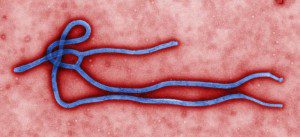

The innate response to virus infection is a marvel: when confronted with an invading microbe, it responds rapidly by producing interferons and other cytokines which establish an antiviral state. Its effectiveness is underscored by the fact that every viral genome must encode countermeasures that modulate its activity. A recent paper in PNAS adds another mechanism to the evasion toolbox of Ebola virus.
The cellular protein tetherin is encoded by a gene whose transcription is induced by interferon, a so-called interferon-induced gene (ISG). The protein is found on the plasma membrane and in perinuclear compartments of the cell. Last year several groups demonstrated that the presence of tetherin in cells causes retention of retrovirus particles at the cell surface. The tethered particles are taken up into the cell, thereby reducing the yield of infectious virus. As would be expected, an HIV-1 protein – Vpu – inhibits the activity of tetherin. When Vpu is present, tetherin has no effect on the yield of HIV-1.
Because it is not possible to work with infectious Ebola virus except under strict containment, the authors instead studied virus-like particles (VLPs), which can be produced in cells by the synthesis of the viral VP40 protein. VLPs lack the viral genome and are not infectious. VLPs are readily produced in a cell line, 293T, which synthesizes very little tetherin. However, when tetherin was synthesized in 293T cells, the yield of VLPs was dramatically reduced, and the particles were retained at the cell surface.
The reduction of VLP yield by tetherin was overcome by synthesis of the Vpu protein of HIV-1. This finding prompted the authors to ask whether the genome of Ebola virus encodes a protein like Vpu that can antagonize tetherin restriction. They found that synthesis of the viral glycoprotein (GP) allowed VLP production in 293T cells in the presence of tetherin. Although the mechanism by which GP counteracts tetherin was not deciphered, the authors did find that GP binds tetherin directly. Furthermore, GP must remain anchored to the plasma membrane in order to exert its anti-tetherin activity.
It will be of great interest to determine how Ebola virus GP and proteins of other viruses permit virion budding from cells in the presence of tetherin. The results of such studies will not only contribute to our understanding of virion maturation, but could also suggest ways to produce a broad-spectrum inhibitor of enveloped viruses.
Kaletsky, R., Francica, J., Agrawal-Gamse, C., & Bates, P. (2009). Tetherin-mediated restriction of filovirus budding is antagonized by the Ebola glycoprotein Proceedings of the National Academy of Sciences, 106 (8), 2886-2891 DOI: 10.1073/pnas.0811014106

Pingback: Marburg virus travels to the US
There are known the receptors of human cells which the ebola virus joins ? Is the well-read one who has studied the interaction of the protein VP35 but not understand the function, also it was speaking about the interaction with a RNA that tape-worm effect on the evasion of the immune response.
There are known the receptors of human cells which the ebola virus joins ? Is the well-read one who has studied the interaction of the protein VP35 but not understand the function, also it was speaking about the interaction with a RNA that tape-worm effect on the evasion of the immune response.